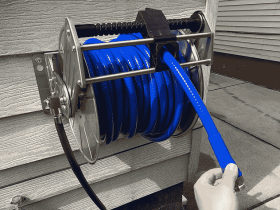Painting your home is one of the most effective and affordable ways to give it a fresh, new look. However, while it may seem like a straightforward task, there are actually many mistakes you can make along the way, a lot of them very common, and can result in an unsatisfactory finish. Whether you’re painting interior walls, ceilings, or exteriors, avoiding these pitfalls will help ensure a professional-looking result. Below are the most critical mistakes to avoid when painting your home.
1. Not Considering Professional Help
The first mistake people make is not considering the help of a professional. Sometimes, it is just best to call in a professional. For instance, if you have no time, have lots of your home to paint, or the area you are painting is just more challenging to do, getting professionals is wholly recommended. Professional painters have experience in achieving a flawless finish, using the right materials, and completing the job efficiently. Hiring a professional is also a worthwhile investment if you lack the skills or patience to do it properly. Many painting professionals offer competitive pricing, and the results often far outweigh the cost. Consulting a professional can save time, reduce stress, and ensure a high-quality outcome.
Additionally, professionals have access to high-quality paints, specialized tools that can paint hard-to-reach areas, and techniques that may not be readily available to DIY painters. They can also offer expert advice if that is what you need on color selection, paint finishes, and long-term maintenance, ensuring your home looks its best for years to come. By hiring a professional painter London, you can enjoy a hassle-free painting experience and achieve a polished, professional look without the effort and uncertainty of a DIY project. You can be certain you won’t be experiencing any of the common mistakes that people make when painting.
2. Underestimating the Time and Effort Required
Painting takes time and effort, and many homeowners underestimate how long the job will take. Setting realistic expectations and allowing ample preparation, painting, and drying time is important. This is why enlisting help, especially for large spaces, can make the task more manageable. Taking breaks to maintain focus and precision will lead to a more professional finish.
3. Skipping Proper Preparation
If you still choose to do it yourself, there are lots of other common mistakes you can fall into making. One of the biggest problems is the failure to prepare the surface properly before painting. A rushed job can result in paint peeling, uneven coverage, or an overall unpolished look. Before starting, it is essential to clean the walls. Walls should be washed with a mild detergent solution to remove dirt, grease, and stains, while any holes, cracks, or imperfections should also be repaired with filler or spackling paste. Sanding the surface is another necessary step to creating a smooth base for the paint to adhere to, particularly if the current surface is flossy.
4. Choosing the Wrong Paint Type
Selecting the wrong type of paint for the purpose you want can impact the final appearance and durability. For instance, if you choose matte and flat finishes, while they work well in low-traffic areas, they can be difficult to clean. If you want to paint high-traffic areas, semi-gloss and gloss finishes are excellent because they are easier to clean and moisture-resistant. For exterior surfaces, weather-resistant paint should be used to withstand the elements. Making the right choice ensures that your paint job is both aesthetically pleasing and practical.
5. Ignoring Primer
Skipping the primer can lead to patchy and uneven results, especially when covering dark colors or painting over glossy surfaces. Primer helps seal porous surfaces to prevent excessive absorption of paint and provides a uniform base for better adhesion. It also improves the durability of the paint job. Always using a primer when necessary is particularly important if you make a drastic color change or paint over surfaces like wood or drywall.
6. Not Testing Paint Colours
Paint can look very different on the wall compared to how it appears on a swatch or in the tin. Lighting, wall texture, and surrounding decor can affect a color’s appearance. To avoid disappointment, test a small section of the wall with a sample before committing to a full room. Observe this throughout the day and consider how it interacts with your furniture and décor. This can help you make the right choice.
Read more: The Ultimate Guide To Hire Commercial Painting Contractor
7. Applying Too Much or Too Little Paint
Applying too little paint can result in an uneven, streaky finish, while applying too much can lead to drips and an unprofessional look. It is such a delicate balance to get right, so the number one recommendation is to reach out to professionals if you want that quality finish. Those brave enough to try it should use a roller for large areas and a brush for edges and corners. Applying at least two thin, even coats rather than one thick coat is recommended. Allowing each coat to dry completely before adding the next ensures a smooth, even finish.
8. Using Low-Quality Brushes and Rollers
Investing in good-quality brushes and rollers is essential for a professional finish. Cheap brushes can leave streaks, shed bristles, and make application difficult. High-quality tools provide better paint coverage, reduce streaks and roller marks, and make the job faster and more efficient. Spending a little more on good brushes and rollers can make a noticeable difference in the final result.
9. Ignoring Weather Conditions for Exterior Painting
If you are painting the exterior of your home, weather conditions play a crucial role. Avoid painting in direct sunlight, as this can cause the paint to dry too quickly and result in cracking or peeling. High humidity can slow drying time and affect adhesion, while rainy or extremely cold conditions can compromise the durability of the paint. The best conditions for exterior painting are dry, mild temperatures with low humidity.
10. Neglecting Ventilation
Painting in a poorly ventilated area can be uncomfortable and hazardous due to fumes. Ensuring proper airflow by opening windows and doors, using fans to circulate air, and wearing a mask if using strong-smelling paints or chemicals is crucial. Good ventilation improves safety and helps the paint dry more evenly.
11. Not Removing Painter’s Tape Properly
Painter’s tape is great for creating clean lines, but if removed incorrectly, it can pull off paint and ruin the finish. Removing the tape slowly at a 45-degree angle while the paint is still slightly wet prevents tearing. If the paint has dried, using a utility knife to score the edges before pulling the tape ensures clean, crisp lines.
Conclusion
Painting your home can be a rewarding and cost-effective way to refresh your space, but avoiding common mistakes is essential for a professional-looking result. From proper preparation to using the right tools and techniques, paying attention to detail will ensure a smooth and lasting finish. By taking your time, knowing when to call in a professional, and avoiding these pitfalls, you can achieve a high-quality paint job that enhances the beauty of your home.











Leave a Review